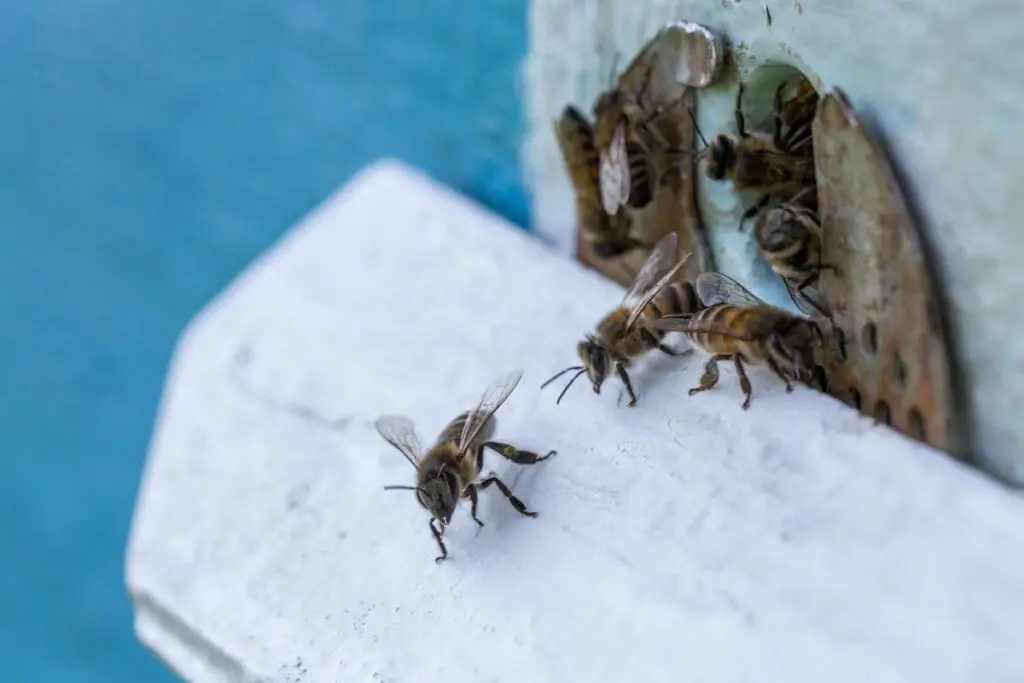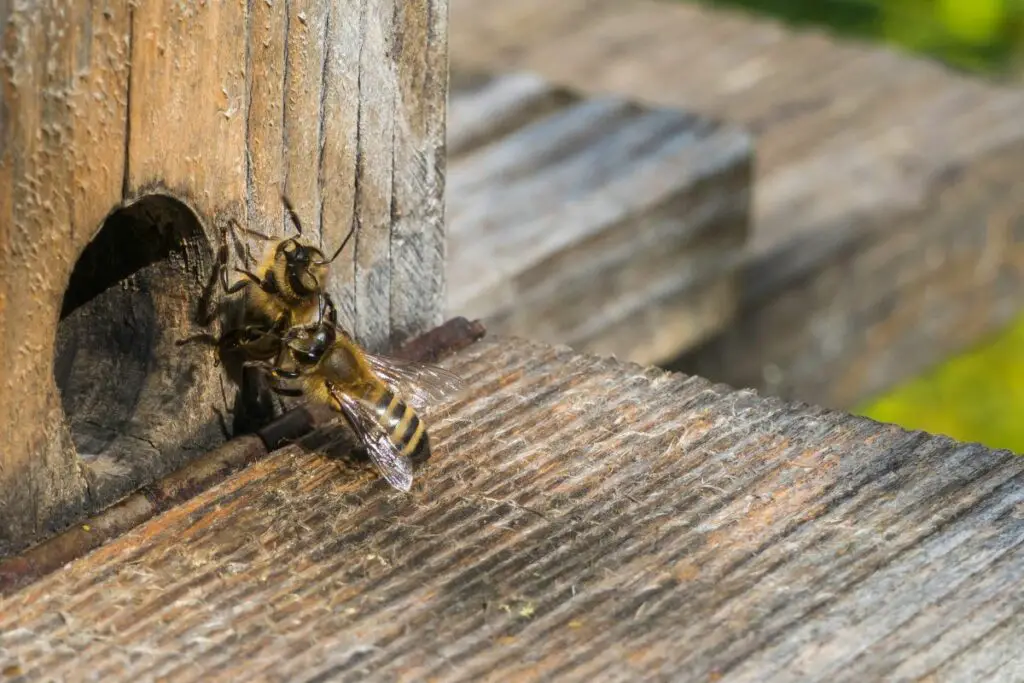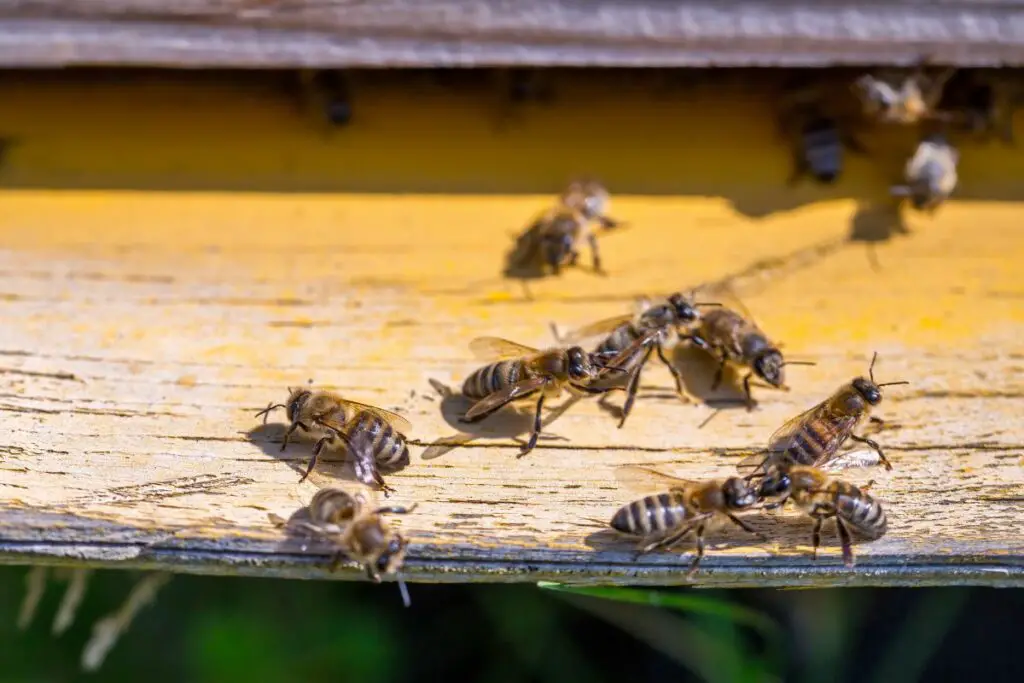Guard bees are the frontline defence of any bee colony. They assess every visitor approaching the hive or nest.
How do these bees identify friends from foes, and what kinds of unwanted guests do these bees have to look out for?
From friend to intruder, let’s see how guard bees fit into the hive and how their actions can mean life or death for their fellow bees.
What Do Guard Bees Do?
Guard bees serve as the vigilant sentinels of their hive.
Stationed at the hive entrance, they scrutinize each incoming bee, using a combination of scent and visual cues to distinguish friend and foe.
Their heightened sensitivity to pheromones and a keen awareness of the hive’s unique odour fingerprint are crucial to their effectiveness.
In the face of threats, they exhibit remarkable responsiveness and communication skills. They rapidly assess the danger and release alarm pheromones to alert their fellow bees.
This triggers a coordinated defence mechanism, mobilizing other bees to the entrance to bolster the hive’s security.
A real-world example of this intricate defence system can be observed in the presence of a wasp near a bee hive. Guarding bees recognize the wasp as a threat because of its distinct smell and aggressive behaviour.
They swiftly signal other bees using alarm pheromones before their hive erupts into a flurry of defensive activity, with numerous bees rushing to the entrance, ready to defend their home.
This coordinated strategy can overwhelm even the largest of bee predators.
They attack with repeated stings that can dispatch smaller insects and cause enough discomfort to drive away larger mammals.

The Lifecycle Of A Guard Bee
| Age (in Weeks) | Roles (Type of Bee) | Description |
|---|---|---|
| 1st Week | Cleaning and feeding the larvae (Nurse Bee) | Newly emerged worker bees tend to hive and feed the brood. |
| 2nd Week | Producing wax, building combs, and processing honey (House Bee) | Bees transition to wax production and comb building inside the hive. |
| 3rd Week | Receiving nectar, ventilating the hive, and packing pollen (Processor Bee) | Role shifts to processing incoming nectar and maintaining hive temperature. |
| 4th Week | Guarding the hive and inspecting incoming bees (Guard Bee) | Bee becomes responsible for hive defence and monitors hive entrance. |
| 5th Week | Foraging for nectar, pollen, water, and propolis (Forager Bee) | The bee leaves the hive to gather food and materials for the colony. |
The lifecycle of a guard bee is a fascinating journey, deeply intertwined with the age-based division of labour in a colony.
Worker bees undergo a series of task-specific phases as they age. They perform duties inside the hive, like cleaning, nursing the young, and attending to the queen.
As they mature, their roles shift towards more complex tasks like building wax combs, processing nectar, and ventilating the hive.
Guard duty comes into play in the later stages of a worker’s life, usually when they are about two to three weeks old.
These bees have now developed the necessary physical and behavioural traits for guard duties, like the ability to produce alarm pheromones.
Younger worker bees are busy inside the hive, tending to the brood and processing honey, while their older counterparts take on guard duties at the hive entrance.
This age-based division of labour means that each bee contributes to the colony’s overall well-being, showcasing honey bee societies’ incredible organization and efficiency.
What Are They Guarding Against?
Our ever-vigilant bees have their hands full protecting their hive from various threats.
- Mammals: Mammals like bears, skunks, and mice pose significant risks to bee colonies. Bears are notorious for attacking hives searching for honey and bee larvae(a rich protein source). Skunks prey on bees at night, eating them directly from the hive entrance. Mice, particularly in colder months, can invade hives for warmth and food, causing structural damage and eating honey and bee brood.
- Robber Bees: Robber bees, which come from other bee colonies, are a major concern. These bees attempt to steal honey, especially during scarce nectar flow. They can create chaos and deplete the hive’s vital resources. Sentry bees are adept at spotting these intruders by their behaviour and scent, battling to the death to protect their stores.
- Other Insects: The hive also faces threats from various other insects. Hornets and wasps, for example, can attack bee colonies to feed on the bees or their larvae. Some species of ants and other small insects may invade hives to steal honey. Bees vigilantly defend against these invasions, engaging in fierce combat to protect their hive.

Guards In Other Insect Species
Having guard members is not unique to honeybees; it’s a behavioural trait in various insect species.
These guards play crucial roles in protecting their colonies, nests, or territories from unwanted predators.
- Ants: Many ant species exhibit guard behaviours, especially in species that build complex colonies. Guard ants are often larger and more aggressive, defending the nest entrance against predators and rival ant colonies. They also maintain order within the nest and manage traffic at the entrance.
- Termites: Similar to ants, termites have specialized soldiers or guards. These termites have more prominent, stronger mandibles and some can even secrete defensive chemicals. They are responsible for defending their colonies from predators, particularly ants and other termite species.
- Wasps: In some wasp species, particularly those that build large communal nests, certain individuals act as guards. These guards protect the nest from threats like predators or competing wasp colonies. They also control access to the nest, ensuring only colony members enter.
An illustrative example is observed in the leafcutter ant, known for its well-organized colonies. Guard ants are stationed strategically, especially when leaves are brought into the colony.
These guards inspect incoming material for parasitic insects or other threats, showcasing a sophisticated level of colony defence akin to guard bees.




